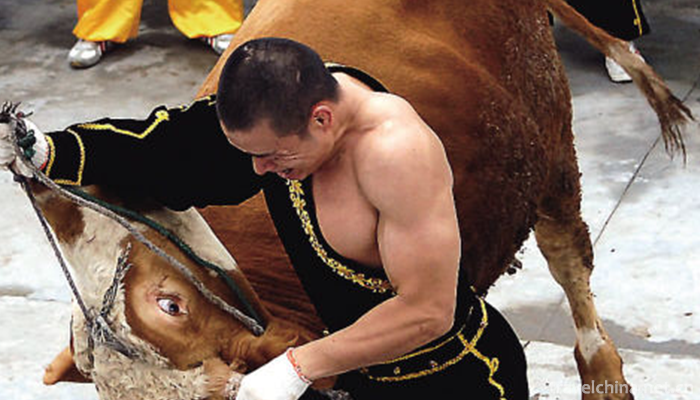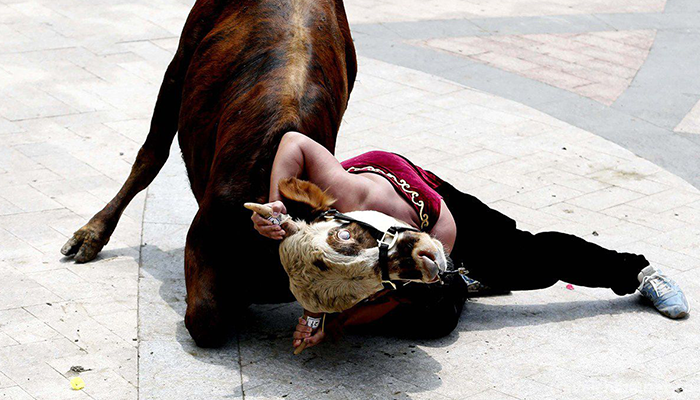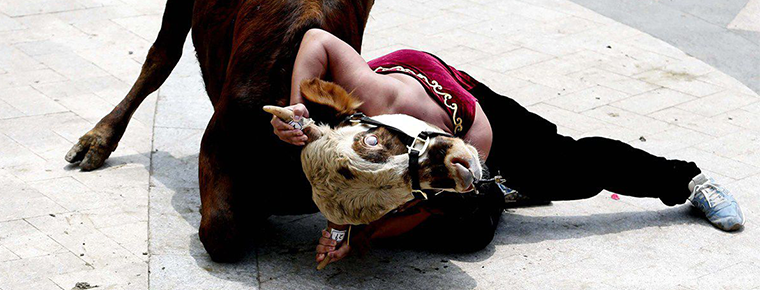Bullfight
Bullfight
Bull-wrestling is a traditional competitive sport of the Hui people. It means throwing, wrestling and throwing. It can also be called bullfighting of the Hui people. The Hui's bullfight is different from the Spanish bullfight. The Spanish bullfight needs to stab the bull with a sword. But the Hui people's cows, without any weapons, completely rely on personal courage and physical strength to throw the cattle down.
origin
The activity of cattle-feeding has been paid more attention in Hui inhabited areas, which is closely related to the Hui people's preference for beef and the frequent slaughter of cattle. Legend has it that a long time ago, there was a returning camp, living in nearly a thousand families, they have to slaughter hundreds of cattle every year during the Eid al-Adha. Every time the cattle were slaughtered, four or five strong young men took ropes and sticks and tied them together and fell. On one occasion, when a bull was tied up, a young man was injured by the bull. Soon he became "impermanent", and the villagers were very sad about it. On the second year of Eid al-Adha, there was a brave and intelligent young man, who was quick-sighted and did not need help. One man threw the cattle down with quick action. The villagers are full of praise and legends. Under his influence, every year to the Eid al-Adha, there are many shrewd young men to grab cattle one by one. Since then, cowling has become a traditional sports activity favored by the Hui people. Every year, the Eid al-Adha Festival specializes in performing.
rule
There are no strict rules for cow-rolling, mainly for the purpose of cattle-rolling in a certain period of time according to the strength and skills of each person. When the Hui people perform with cows, they are usually smart and flexible. When facing the big bull with sword-like antennae and thunderous jump, they step forward, grasp two horns with both hands, concentrate on them, and twist the head of the bull to one side. Then they immediately take the chin of the bull with their right shoulder and force the neck of the bull to another. The front feet of the bull kneel down immediately, and then press the neck of the bull forcefully through a series of twisting, carrying and pressing. The action brought down the bull and made it look up on all fours.
The rules are simple and the process is unique. The cowman's assistant first flirted with the cattle, causing them to run across the field. At this time, the Cowman appeared on the stage, facing the angry bull, the Cowman chose two hands to pull the horns of the bull, twist the head to one side, the cow struggled hard, the Cowman immediately held the head tightly, shouldered the chin of the cow, exerted all his strength, put his body on the neck of the cow, Newton lost balance, fell to the ground. This skill of twisting, carrying and pressing a cow is the main characteristic of a cow.
The state of cattle falling to the ground is divided into four grades according to the degree of technical difficulty.
Kneel on both knees (Level 4)
Abdominal landing (level 3)
Side to side (Level 2)
Four feet facing the sky (level 1)
The criteria for evaluating a cow depend on the skill of the Cowman and the different types of cattle falling to the ground. The types of cattle are single-arm, double-arm, shoulder, shoulder and so on.
On May 23, 2011, cows were listed in the third batch of national intangible cultural heritage list with the approval of the State Council.
Relevant
The Hui people's cows participated in the performance at the National Minority Sports Conference in 1982, and the audience applauded warmly. They were welcomed and praised by brothers and foreign Muslim friends.
cultural heritage
On May 18, 2010, the Ministry of Culture of China announced the third batch of national intangible cultural heritage list of recommended projects (new entries). Nanhu District, Jiaxing City, Zhejiang Province, declared the "cow" was included in the intangible cultural heritage of traditional sports, recreation and acrobatics.



-
1.Chibi ancient battlefield
The ancient battlefield of Chibi in the Three Kingdoms, where the battle of Chibi took place, is located on the South Bank of the Yangtze River in the northwest of Chibi City, Hubei Province
Time 2018-12-12 -
2.Dalian Modern Museum
Dalian Modern Museum is located at No. 10 Convention and Exhibition Road, Shahekou District, Dalian City. It is located in the northwest side of Xinghai Square. It is the first comprehensive museum na
Time 2019-01-07 -
3.Wulingyuan
Wulingyuan Scenic Spot is located in the northwest of Hunan Province, central China. Its longitude is 110 20'30 ~110 41'15 and latitude is 29 16'25 ~29 24'25
Time 2019-02-24 -
4.The Forging Skill of Achang Husha Knife
Achang household knife forging technology, Yunnan Dehong Dai Jingpo Autonomous Prefecture Longchuan County household Sa Township traditional handicraft, one of the national intangible cultural heritag
Time 2019-03-28 -
5.Dark pass
Dark pass Dark Biography, as the first Creation Epic of the Han nationality, is represented by folk songs and songs. It began to circulate in the Ming and Qing Dynasties.
Time 2019-05-03 -
6.Li Nationalitys Wood Drilling and Fire making Techniques
Li people's wood-drilling and fire-making skills, Hainan Province's local traditional handicraft, one of the national intangible cultural heritage.
Time 2019-05-13 -
7.Miao brocade weaving skills
Miao brocade is woven by Miao women using silk, ramie, kapok and other fibers produced locally. Miao brocade, also known as weaving flowers, is a pattern fabric formed by weaving. The color weft is fu
Time 2019-06-05 -
8.Awakening Drama
Yongkang Xinggan Opera, also known as "Jianggan Opera", is a traditional opera that serves religion. Mainly to persuade people to reflect, guide people to rectify, mainly in sacrificial occa
Time 2019-07-08 -
9.Chinese Qiang Museum
Qiang museum is a local ethnic Museum, located in the south of Qiangxing street in Maoxian county. It was officially opened in 1988 when the Qiang traditional festival "Qiang calendar year". It is the only Qiang Museum in China.
Time 2020-11-06 -
10.Jiajinshan National Forest Park
Xiaojin County of jiajinshan National Forest Park is located at the northern foot of Jiajin mountain in the east of Xiaojin County, Aba Tibetan and Qiang Autonomous Prefecture, Sichuan Province.
Time 2020-11-07 -
11.Neijiang climate
Neijiang City belongs to subtropical humid monsoon climate. Affected by the basin and the natural environment, it has the characteristics of mild climate, abundant rainfall, sufficient light and heat, and long frost free period. It is warm in winter and hot in summer,
Time 2020-12-16 -
12.Meishan City logo
Meishan City logo is composed of ancient Chinese tile pattern and Dongpo head portrait, which shows a feeling of ancient historical traces and reflects the ancient culture of Meishan. From the design to the font are used a simple style, using the combinatio
Time 2020-12-18